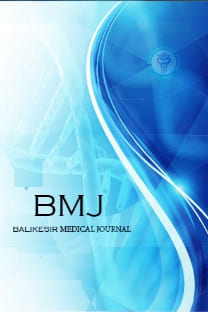Nitrofurazona Bağlı Alerjik Kontakt Dermatit: 22 Olgudan Oluşan Bir Çalışma
Allergic Contact Dermatitis due to Nitrofurazone: A Study of 22 Cases
___
- 1. Kligman AM. The identification of contact allergens by human assay. 3. The maximization test: a procedure for screening and rating contact sensitizers. The Journal of investigative dermatology 1966; 47(5): 393-409.
- 2. Bajaj AK, Saraswat A, Mukhija G, Rastogi S, Yadav S. Patch testing experience with 1000 patients. Indian journal of dermatology, venereology and leprology 2007; 73(5): 313-318.
- 3. Downing JG, Brecker FW. Further studies in the use of furacin in dermatology. The New England journal of medicine 1948; 239(23): 862-864.
- 4. Bordere A, Stockman A, Boone B, Franki AS, Coppens MJ, Lapeere H, et al. A case of anaphylaxis caused by macrogol 3350 after injection of a corticosteroid. Contact dermatitis 2012; 67(6): 376-378.
- 5. Stenveld HJ, Langendijk PN, Bruynzeel DP. Contact sensitivity to polyethylene glycols. Contact dermatitis 1994; 30(3): 184-185.
- 6. Braun W. [Contact allergies to polyethylene glycols]. Zeitschrift fur Haut- und Geschlechtskrankheiten 1969; 44(11): 385-389.
- 7. Bajaj AK, Gupta SC, Chatterjee AK, Singh KG. Contact sensitivity to polyethylene glycols. Contact dermatitis 1990; 22(5): 291-292.
- 8. Ozkaya E, Kilic S. Polyethylene glycol as marker for nitrofurazone allergy: 20 years of experience from Turkey. Contact dermatitis 2018; 78(3): 211-215.
- 9. Guijarro SC, Sanchez-Perez J, Garcia-Diez A. Allergic contact dermatitis to polyethylene glycol and nitrofurazone. American journal of contact dermatitis : official journal of the American Contact Dermatitis Society 1999; 10(4): 226-227.
- 10. Prieto A, Baeza ML, Herrero T, Barranco R, De Castro FJ, Ruiz J, et al. Contact dermatitis to Furacin. Contact dermatitis 2006; 54(2): 126.
- 11. Saap L, Fahim S, Arsenault E, Pratt M, Pierscianowski T, Falanga V, et al. Contact sensitivity in patients with leg ulcerations: a North American study. Archives of dermatology 2004; 140(10): 1241-1246.
- 12. Erfurt-Berge C, Geier J, Mahler V. The current spectrum of contact sensitization in patients with chronic leg ulcers or stasis dermatitis - new data from the Information Network of Departments of Dermatology (IVDK). Contact dermatitis 2017; 77(3): 151-158.
- 13. Ozkaya E, Polat Ekinci A. Foot contact dermatitis: nitrofurazone as the main cause in a retrospective, cross-sectional study over a 16-year period from Turkey. International journal of dermatology 2016; 55(12): 1345-1350.
- Yayın Aralığı: Yıllık
- Başlangıç: 2017
- Yayıncı: Balıkesir Üniversitesi
Anıl TURHAN ÇAKIR, İsa Şükrü ÖZ, Burak ÜN
Tonsillektomi Vakalarında Malignite Oranı: Geriye Yönelik Analiz
Emine Zeynep TARİNİ, Leymune PARLAK
Sjögren Sendromu olan Hastalarda Nötrofil/Lenfosit ve Trombosit/Lenfosit Oranlarının Araştırılması
Serap DURMUŞOĞLU ERBEN, Fatih KILIÇ, Mehmet ÜNSAL, Okan AYTEKİN, Günsu KİMYON CÖMERT, Alper KARALÖK, Osman TÜRKMEN, Ömer Lütfi TAPISIZ, Taner TURAN, Gökhan TULUNAY
Alt Üriner Sistem ve Penis Travmaları Deneyimlerimiz
Murat DEMİR, Recep ERYILMAZ, Kerem TAKEN, Şeyhmuz ARAZ
Nitrofurazona Bağlı Alerjik Kontakt Dermatit: 22 Olgudan Oluşan Bir Çalışma
Kolon Poliplerinin Ayırıcı Tanısında Yeni Bir Yaklaşım; Stereoloji
Ferah TUNCEL, Elif DEMİRCİ, Nesrin GÜRSAN
Covid-19 Şüphesi ile Başvuran Hastalarda Antikor Kimliği ve Diğer Parametreler
Özgür ÇELEBİ, Çiğdem Eda BALKAN BOZLAK, Sibel İBA YILMAZ, Demet ÇELEBİ
